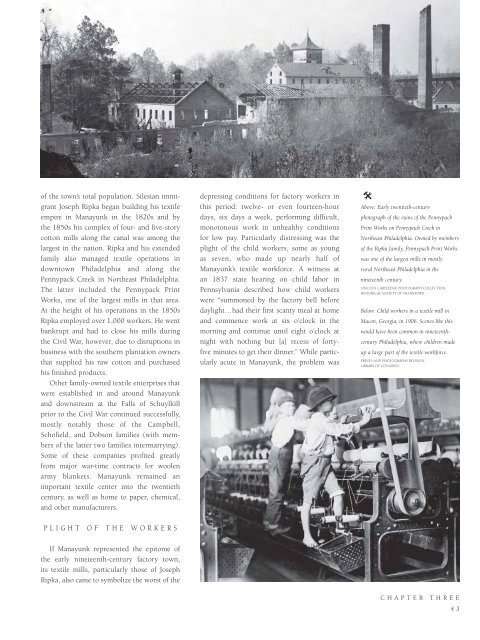In The Cradle of Industry and Liberty
An illustrated history of Philadelphia's manufacturing sector paired with the histories of local companies that make the city great.
An illustrated history of Philadelphia's manufacturing sector paired with the histories of local companies that make the city great.
You also want an ePaper? Increase the reach of your titles
YUMPU automatically turns print PDFs into web optimized ePapers that Google loves.
<strong>of</strong> the town’s total population. Silesian immigrant<br />
Joseph Ripka began building his textile<br />
empire in Manayunk in the 1820s <strong>and</strong> by<br />
the 1850s his complex <strong>of</strong> four- <strong>and</strong> five-story<br />
cotton mills along the canal was among the<br />
largest in the nation. Ripka <strong>and</strong> his extended<br />
family also managed textile operations in<br />
downtown Philadelphia <strong>and</strong> along the<br />
Pennypack Creek in Northeast Philadelphia.<br />
<strong>The</strong> latter included the Pennypack Print<br />
Works, one <strong>of</strong> the largest mills in that area.<br />
At the height <strong>of</strong> his operations in the 1850s<br />
Ripka employed over 1,000 workers. He went<br />
bankrupt <strong>and</strong> had to close his mills during<br />
the Civil War, however, due to disruptions in<br />
business with the southern plantation owners<br />
that supplied his raw cotton <strong>and</strong> purchased<br />
his finished products.<br />
Other family-owned textile enterprises that<br />
were established in <strong>and</strong> around Manayunk<br />
<strong>and</strong> downstream at the Falls <strong>of</strong> Schuylkill<br />
prior to the Civil War continued successfully,<br />
mostly notably those <strong>of</strong> the Campbell,<br />
Sch<strong>of</strong>ield, <strong>and</strong> Dobson families (with members<br />
<strong>of</strong> the latter two families intermarrying).<br />
Some <strong>of</strong> these companies pr<strong>of</strong>ited greatly<br />
from major war-time contracts for woolen<br />
army blankets. Manayunk remained an<br />
important textile center into the twentieth<br />
century, as well as home to paper, chemical,<br />
<strong>and</strong> other manufacturers.<br />
depressing conditions for factory workers in<br />
this period: twelve- or even fourteen-hour<br />
days, six days a week, performing difficult,<br />
monotonous work in unhealthy conditions<br />
for low pay. Particularly distressing was the<br />
plight <strong>of</strong> the child workers, some as young<br />
as seven, who made up nearly half <strong>of</strong><br />
Manayunk’s textile workforce. A witness at<br />
an 1837 state hearing on child labor in<br />
Pennsylvania described how child workers<br />
were “summoned by the factory bell before<br />
daylight…had their first scanty meal at home<br />
<strong>and</strong> commence work at six o’clock in the<br />
morning <strong>and</strong> continue until eight o’clock at<br />
night with nothing but [a] recess <strong>of</strong> fortyfive<br />
minutes to get their dinner.” While particularly<br />
acute in Manayunk, the problem was<br />
@<br />
Above: Early twentieth-century<br />
photograph <strong>of</strong> the ruins <strong>of</strong> the Pennypack<br />
Print Works on Pennypack Creek in<br />
Northeast Philadelphia. Owned by members<br />
<strong>of</strong> the Ripka family, Pennypack Print Works<br />
was one <strong>of</strong> the largest mills in mostly<br />
rural Northeast Philadelphia in the<br />
nineteenth century.<br />
LINCOLN CARTLEDGE PHOTOGRAPH COLLECTION,<br />
HISTORICAL SOCIETY OF FRANKFORD.<br />
Below: Child workers in a textile mill in<br />
Macon, Georgia, in 1906. Scenes like this<br />
would have been common in nineteenthcentury<br />
Philadelphia, where children made<br />
up a large part <strong>of</strong> the textile workforce.<br />
PRINTS AND PHOTOGRAPHS DIVISION,<br />
LIBRARY OF CONGRESS.<br />
PLIGHT OF THE WORKERS<br />
If Manayunk represented the epitome <strong>of</strong><br />
the early nineteenth-century factory town,<br />
its textile mills, particularly those <strong>of</strong> Joseph<br />
Ripka, also came to symbolize the worst <strong>of</strong> the<br />
CHAPTER THREE<br />
43
















